Ylang Ylang is a star-shaped, yellow flower with large, curved petals that is indigenous to the rain forests of many Asian nations, Polynesia and Madagascar.
The name, ylang ylang, derives from the Tagalog word, ilang, which translates to wilderness. Some suggest this is a reference to the manner in which the flowers dangle and dance into the heart of the wind.
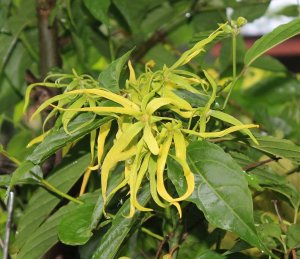
Blooms are bunched very close together in numbers of 4 to 12 on the branches of the fragrant, tropical Cananga tree, which is known to grow up to 40 meters (131 feet) in height. Each bloom has 2 sets of 3 petals, which are at first green, and as they mature, become yellow.
This essential oil’s moniker as the Queen of Perfumes, is well earned, as its exotic, deep and rich fragrance has been used for centuries both for its therapeutic properties and as an ingredient in some of the world’s most iconic fragrances, including Chanel #5, where it serves as a vital aldehyde that forms a link between between the aldehydic head notes and the floral heart notes of dreamy, musky rose and intense, haunting jasmine.
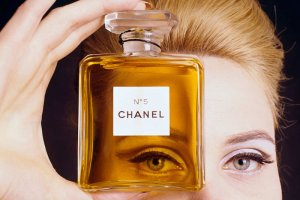
In the modern perfume landscape, ylang yang is a favored ingredient and it is found in the formulations of many of the worlds’s leading perfumers.
Not a lot is known about the origins of this glorious, redolent flower. Some botanists theorize that the ancient civilization of Polynesia spread the use of this flower during its early years of settlement.
Others believe that the flower became popular during the burgeoning stages of European colonialism.
What is known for sure is that it was the French who introduced the commercial cultivation of ylang ylang to the islands of the Indian Ocean in the latter years of the 18th century.
What Does Ylang Ylang Smell Like?
The unique and powerful fragrance of ylang ylang is dreamy and romantic, featuring floral notes nuanced with aspects of creamy, balsamic and powdery custard, intoxicating jasmine, sweet, slightly pungent banana, light and bitter neroli and sensual, sugary honey.
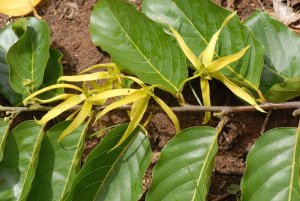
It also blends well with other facets, and its verdant richness is like no other fragrance element in the world. There are chemical compounds that help to define its distinctive character.
The most prominent is linalool, a natural alcohol laden with fresh, floral facets. Ylang ylang is most often found in feminine products and perfumes, but it is also sometimes incorporated into more masculine scents, aided by notes like creamy sandalwood and green, musty and balsamic vetiver.
Where Does Ylang Ylang Come From?
The process of steam distillation is used to extract the essential oil from its precious floral source. This method vaporizes volatile compounds that are carefully collected and compressed.
A grading system classifies the diverse types of ylang ylang, and depending on how it will be used, extraction will vary in strength. Perfume, for example, requires a more potent concentration than cosmetic products.
The most potent and expensive form of this essential oil extract is known as Extra, and it contains the highest concentration of natural, organic compounds such as: linalool, geranyl acetate and benzyl acetate.
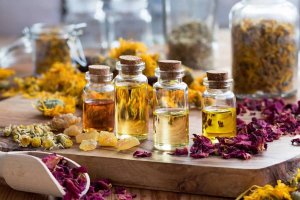
This variety is most commonly found in distinctive perfumes because of its refined, rich and sophisticated scent. “First”, “Second” and “Third” variations differ in potency, with “Third’” being the mildest.
Ten to twenty hours of continuous distillation creates an essential oil known as “Complete”, which is a combination of all four stages of distillation, and it contains the heaviest amounts of redolent facets like betacaryophyllene (BCP) and germacrene, both of which render deep, floral and fruity tones to any Alpha Aromatics’ fragrance containing ylang ylang.
The Many Benefits of Ylang Ylang
This iconic fragrance has been used in aromatherapy for centuries untold as a means to alleviate symptoms associated with stress and anxiety. Its soothing character is said to foster a positive mindset and reduce feelings of anger.
It is also commonly used to improve memory and thinking skills, and is a powerful aphrodisiac. In Indonesian culture, these flowers are often sprinkled across the beds of newly-wedded couples.
A 2013 Korean study involving 52 participants indicated that ylang ylang was helpful in reducing blood pressure levels. It is also used in some skin care products, as it is known to normalize the secretion of sebum (the fatty lubricant matter secreted by sebaceous glands of the skin).
A Few Of Our Recent Compositions Featuring Ylang Ylang
Whether it’s for personal care products, candles and reed diffusers, fragrances for home, odor neutralizers, industrial air fresheners, private label brands, household cleaning products and last but far from least, fine customized perfumes, our master perfumers are constantly conjuring new fragrant creations for clients from across the globe.
The following represent just a few of those fragrances that feature Ylang Ylang.
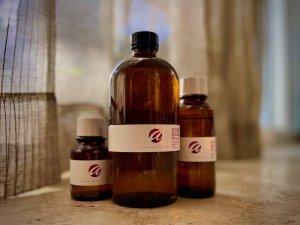
Dirty Fragrances
Peppercorn Jasmine
This invigorating fragrance streams with a top note featuring facets of invigorating citrus sparkle and narcotic, sensual and sweet ylang ylang.
These aspects seamlessly fold into a floral heart note bouquet of fruity, rich and honeyed jasmine sambac, and earthy, balsamic and musty vetiver.
A dry down of sharp, spicy and rosy peppercorn and warm, woody and slightly dry cedar wood complete this sensual perfume.
Amber Fragrances
Wild Saffron And Amber
This unforgettable fragrance flows with head notes of zingy, fruity and green rhubarb, piquant lime and bittersweet, intimate and leathery saffron.
A middle note soon follows featuring facets of rosy, floral geranium, rich, erotic ylang ylang, soothing, sweet-smelling lavender, powdery violet and deeply sensual and intoxicating jasmine.
A passionate dry down marked by aspects of earthy, erotic musk, green, balsamic vetiver, musky and potent patchouli and warm, rich and honeyed amber complete this beguiling scent.
Facial Skin Products
Blue Agave And Sea Salt
This sea-inspired fragrance streams with opening facets of mild, sugary casaba melon, fuzzy, fatty apricot kernel and ozonic, marine sea salt.
These elements soon drift into a heart note marked by jasmine-nuanced, floral and rich ylang ylang, musky, romantic rose, earthy, green moss, hot, spicy clove and mellow, smooth and sweet blue agave.
A warm dry down of earthy musk, velvety sandalwood and slightly sugary nectar finish this captivating scent.
Ozonic Fragrances
Black Amber Musk
Head notes of complex, green and fruity bergamot, lush mandarin and sharp, black currant open this glorious scent.
These facets soon harmoniously fade into a heart note bouquet streaming with haunting, exotic jasmine, narcotic, rich and sugary ylang ylang, rich, creamy gardenia and vanilla-tinged and powdery orchid.
A dry down marked by aspects of dark, honey-tinged amber, warm sandalwood, passionate, erotic musk, earthy patchouli and lush, noble vanilla finishes this memorable fragrance.
In conclusion
The exotic essence of ylang ylang has a far reach within the world of perfume. Its rich, creamy and romantic elements have charmed centuries of women enamored by its fragrant, dreamy cloud of exotic scent.
Its future looks bright as well, and if you are an enterprise seeking that magical element to add to your feminine products or service, reach out to our perfumers and have them create something unique and specially customized.
Photo Credits: Pixabay, iStock and Jonas Neilson
 alpha aromatics®
alpha aromatics®